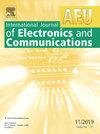Temperature-less-sensitive trans-impedance amplifier with background light cancellation loop
IF 3
3区 计算机科学
Q2 ENGINEERING, ELECTRICAL & ELECTRONIC
Aeu-International Journal of Electronics and Communications
Pub Date : 2025-02-01
DOI:10.1016/j.aeue.2024.155625
引用次数: 0
Abstract
A temperature-less-sensitive photoplethysmography (PPG) sensor integrated circuit with a background light loop for monitoring vital signs is proposed. The proposed PPG sensor contains a low-power trans-impedance amplifier (TIA) with a background light (BGL) loop and a temperature sensing circuit (TSC). The background light loop assists in rejecting the DC photocurrent up to 15 A, improving the total harmonic distortion (THD) by 15.7X. Meanwhile, the TSC improves the TIA’s temperature robustness by more than 14X over a wide range of temperature variations from to . The proposed circuit is designed and analyzed using the signal-flow graph (SFG) strategy to prove the functionality’s performance. In TSMC 0.18 m CMOS technology, the circuit is simulated and occupies a silicon area of 320 m x 345 m, providing seamless integration with the wearable devices. The pre- and post-layout simulation results are matched and consistent with a relative error less than 1 %. Statistical analysis based on Monte-Carlo (MC) and process–voltage–temperature variations (PVTs) have been executed to guarantee the well-functionality performance throughout future manufacture. The post-layout simulation results indicate the midband gain reaches 115 dB and the power consumption is 27 W with a single power supply of 1.8 V. Furthermore, the high-pass corner frequency, the low-pass corner frequency, and the total input referred noise reach 60 mHz, 112 Hz, and 2 pArms, respectively. Out of the figure of merits (), the functionality performance of the proposed circuit has been verified with a perfusion index (PI) of 3.3 % and performs superior to the prior arts.
求助全文
约1分钟内获得全文
求助全文
来源期刊
CiteScore
6.90
自引率
18.80%
发文量
292
审稿时长
4.9 months
期刊介绍:
AEÜ is an international scientific journal which publishes both original works and invited tutorials. The journal''s scope covers all aspects of theory and design of circuits, systems and devices for electronics, signal processing, and communication, including:
signal and system theory, digital signal processing
network theory and circuit design
information theory, communication theory and techniques, modulation, source and channel coding
switching theory and techniques, communication protocols
optical communications
microwave theory and techniques, radar, sonar
antennas, wave propagation
AEÜ publishes full papers and letters with very short turn around time but a high standard review process. Review cycles are typically finished within twelve weeks by application of modern electronic communication facilities.

 求助内容:
求助内容: 应助结果提醒方式:
应助结果提醒方式:


